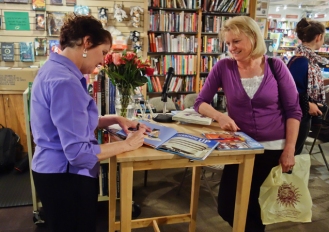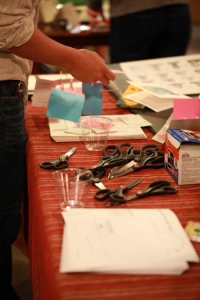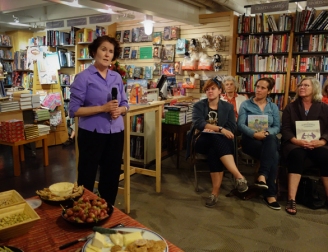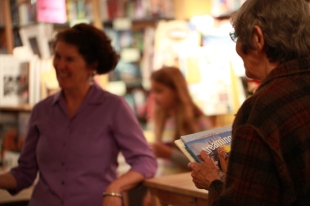
Lulu Delacre is the author and illustrator of many award-winning children’s books, including H ow Far Do You Love Me? and Arrorró, mi niño. In this guest blog post Lulu shares the valuable lessons she’s learned in her journey from illustrator to author.
ow Far Do You Love Me? and Arrorró, mi niño. In this guest blog post Lulu shares the valuable lessons she’s learned in her journey from illustrator to author.
“Me? Write a Story? In a language not my own? I can’t! I graduated from art school!”
That was my reaction to the suggestion of editors and art directors from children’s publishers in New York who saw my sketches back in 1984. From the doodles of my boredom a character had been born, complete with a name and attributes, and I shopped him around in the hopes of illustration assignments.

art from Arrorró, mi niño
The scheduled interviews led to a meeting with Barbara Lucas, former assistant editor to the legendary Ursula Nordstrom at Harper & Row. Barbara was the first of several great editors throughout my career who have provided me with enlightening advice. “Your character needs a friend,” Barbara said. At that suggestion my self-imposed handicap began to erode. I thought, what if Nathan is asleep one night and a mouse comes into his room and sets up house in his toy chest? That question, the many sketches that followed, the clumsy first manuscript, and my editor’s guidance, led to the first book I ever wrote and illustrated: Nathan and Nicholas Alexander.
In the process I discovered two things: first, as long as I am creative and willing to learn I can channel my natural creativity into another means of communication, and second, writing in a language not my own requires discipline, humility, and the ability to listen to those who are willing to share an honest opinion so I can improve my skills. Since that first book I’ve authored many more, and all but one are illustrated by me. Along the way I’ve learned some valuable lessons:
Read Good Literature
Early on I spent hours in the children’s section of my public library reading books. Once I transcribed the text of Sendak’s Where the Wild Things Are, to learn the cadence and rhythm of a picture book story I regard as perfect. This exercise allowed me to see that in a great picture book the words, images, and design all work in perfect harmony to transport the reader into the world of the story. Today I’m an avid reader of adult fiction and nonfiction and know that reading improves my writing skills.
Write from the Heart
I create books that speak to me and that I would have wanted to read when young. I create books that I must share with the children in my life and that my inner voice tells me should be on the market.
The Story Comes First Unless the Character Comes First
As an artist this must have been my hardest lesson! If I am writing a story that is not character driven, editing a collection of folklore, or writing for an older audience, I always concentrate on the manuscript first. I revise, edit, revise some more, and only when the manuscript is ready will I don my artist’s hat to determine the perfect art to complement and enrich the story. This is a cardinal rule that I only break when a picture book character is born out of my sketches. Then I’ll draw the character doing all sorts of things until I get to know him or her. Knowing my character enables me to write the character into situations and imagine how he or she would behave.
Read Your Manuscript Aloud
As a native Spanish speaker, I still make a lot of mistakes that I am most likely to catch when I listen to my own words. Silent reading can conceal many grammatical errors!
Ask Writer Friends to Critique Your Work
Since my native tongue is Spanish, there are times when my brain delivers literal translations. The English sentence may be correct, but awkward. This is when my critique group is essential, pointing these out. Then I can choose if I want to leave it as is for the “Latino” flavor or if it’s better to reword the sentence or passage.
Read Your Work to Your Intended Audience
Sharing my work with kids when I go to schools and libraries is invaluable. This is when I learn what does and doesn’t work.
Patience and Persistence
I’ve learned to allow a story to percolate slowly until I know I am ready to write it. Once I have written it I am very persistent and do not get discouraged by rejections of a project in which I truly believe. Twenty-two publishers rejected one of my submissions before it was published and became a commercial success.
When Stuck, Draw
The most important thing is to be creative. So when I run into writer’s block, I draw, paint, or take a walk in the neighborhood. I came up with the poem for my latest book, How Far Do You Love Me?, during a forty-five-minute walk on a cloudless fall day!
Today I can proudly say that I am the illustrator of thirty-four books and the author of seventeen of those. I feel as comfortable illustrating another author’s manuscript as I feel writing my own. I can say this because I listen carefully to my inner voice, my critique group, and my editors. I love a challenge and find there is nothing more challenging than being the author/illustrator of a children’s book!

artwork from Lulu’s latest title, How Far Do You Love Me?
For more information about Lulu Delacre visit luludelacre.com.
Filed under:
guest blogger,
Publishing 101,
Resources Tagged:
author advice,
illustrator advice,
Lulu Delacre,
tips on becoming an author 

 In her first guest post, author/illustrator Christy Hale shared ideas for how to plan a successful book launch. In her follow-up post, Hale shares tips for planning storytelling and activities for bookstore appearances. Hale is the author and illustrator of, most recently, Dreaming Up, which was named a 2012 ALA Notable Book by the American Library Association and one of the Horn Book Magazine‘s Best Books of 2012.
In her first guest post, author/illustrator Christy Hale shared ideas for how to plan a successful book launch. In her follow-up post, Hale shares tips for planning storytelling and activities for bookstore appearances. Hale is the author and illustrator of, most recently, Dreaming Up, which was named a 2012 ALA Notable Book by the American Library Association and one of the Horn Book Magazine‘s Best Books of 2012.
1. Consider the audience when planning your program. Bookstores host different types of author events. If possible attend other programs at bookstores where you will appear so you can scope out the typical crowd. The time of the event may be a good indicator of the age level likely to attend. At Kepler’s Story Time Sundays, I have read to toddlers and preschoolers with a few older school age children scattered in the mix. A mid-week morning time program at BookSmart in a shopping mall in San Jose drew in moms and caregivers with toddlers and preschoolers. An afternoon program at Linden Tree in Los Altos brought school age children. An early evening program at Reach and Teach in San Mateo was geared toward whole families. My evening launch party at Books Inc. in Palo Alto was mostly attended by adults.

2. Plan age-appropriate readings and activities. Attention span and developmental abilities vary from one age group to another.
- 2-3 year olds have an attention span of 3-4 minutes. They like repetition and imitation. They understand actions and objects.
- 4-5 years olds have an attention span of 5-10 minutes. They love fantasy and have great imagination.
- 6-8 year olds have an attention span of 15-20 minutes. They are concrete and literal minded. They can understand chronological sequence.
- 9-12 year olds have an attention span of 30-45 minutes. They like to be challenged and can learn abstract concepts.Try these ideas when reading aloud:
- Practice reading ahead of time and look for themes in your story. Make a list of questions to ask your audience (Who has seen a _____? Who likes_______?) Find areas of the story that allow for active participation.
- Be expressive! Ham it up and act it out. Enthusiasm is contagious.
- If you have a long story, feel free to skip some parts to adapt to the attention span of your group.
- Invite children to add sounds effects at select points in the story (animal noises, wind blowing, car motor, and so forth). In Elizabeti’s School, Lee & Low author Stephanie Stuve-Bodeen asks children to count to five in Swahili along with her, “Moja, mbili, tatu, nne, tano.”
- Model actions for kids to follow (Look right. Look left. Look up. Look down. Look all around.).
- Ask kids to join in repeating phrases.
- Employ props; bring show and tell. I bring a kanga from Tanzania when I read Elizabeti’s Doll.
- Use visual aids that allow for kid participation, like felt boards, large sketchpads.

3. Consider the physical space allotted for your reading and activity. Will attendees sit in chairs? On a rug? Are there tables for activities? Can attendees spread out on the floor?

4. KISS (Keep It Simple, Stupid)
- Plan activities that involve supplies the bookstore might have on hand (like glue sticks, colored crayons, pencils, and markers) OR provide your own supplies.
- Avoid activities that require water for clean up.
- Design your own activity handouts that can also serve as further promotion.
- Consider open-ended activities that allow children and adults to participate at their own developmental levels.
Here are some examples of bookstore activities I’ve designed that have been a big hit:
Dreaming Up: A Celebration of Building
- BUILD YOUR DREAMS SLOTTED BUILDING CARDS. (downloadable PDF) Materials: scissors, colored pencils, and some big dreams.
- MINI DOMES. Materials: toothpicks and gumdrops.

The East-West House: Noguchi’s Childhood in Japan
- DESIGN YOUR OWN DREAM HOUSE (downloadable PDF) Materials: printouts of PDF, pencils, and imagination. Great lesson for older kids.
- EAST-WEST KIDS COLLAGE (downloadable PDF) Materials: printouts of PDF, recycled patterned business envelopes, scissors, glue sticks, and colored markers.

Further Reading:
How to Plan A Successful Book Launch, Part I
Filed under:
Activities,
guest blogger,
Publishing 101 Tagged:
author advice,
Bookstores,
event planning,
events,
illustrator advice,
marketing,
Reading Aloud 

Came across a link today to a terrific interview with the late, great Maurice Sendak. Authors and illustrators often wonder what the best way is to deal with negative criticism of their books, so I thought I’d share Mr. Sendak’s first-rate advice:
Interviewer: What kinds of things do children write to you about?
Maurice Sendak: Usually it’s awful, because they don’t feel the urge to write themselves—a few of them do, but usually it’s “Dear Mr. Sendak, Mrs. Markowitz said would you please send a free book and two drawings?” When they write on their own, they’re ferocious. After Outside Over There, which is my favorite book of mine, a little girl wrote to me from Canada: “I like all of your books, why did you write this book, this is the first book I hate. I hate the babies in this book, why are they naked, I hope you die soon. Cordially…” Her mother added a note: “I wondered if I should even mail this to you—I didn’t want to hurt your feelings.” I was so elated. It was so natural and spontaneous. The mother said, “You should know I am pregnant and she has been fiercely opposed to it.” Well, she didn’t want competition, and the whole book was about a girl who’s fighting against having to look after her baby sister.
Interviewer: You find the unvarnished truth consoling, even if it’s vicious and painful.
Maurice Sendak: If it’s true, then you can’t care about the vicious and the painful. You can only be astonished. Most kids don’t dare tell the truth. Kids are the politest people in the world. A letter like that is wonderful. “I wish you would die.” I should have written back, “Honey, I will; just hold your horses.”
You can read the rest of the interview in the November/December 2012 issue of The Believer here.
Filed under:
Musings & Ponderings,
Publishing 101 Tagged:
Advice,
author advice,
illustrator advice 

 Quotes and Advice from Ashley Bryan:
Quotes and Advice from Ashley Bryan:
- “If you put art into the world, you will get beauty in return.”
- If I can conjure up the joy of the voice of the book, then the child will want to read. Kids don’t want to be put on the spot. A kid can work with you if you give them time.
- I hold the book as I speak the words so the kids know where the words come from.
- I rejoice in the spirit of the oral tradition.
- Kids need to know how the words will speak through them. This is different for everyone. Work cooperatively, and allow the child to ask you how to pronounce something. This will give them confidence when they perform a poem.
- Poetry infuses fiction and non-fiction.
- I hope that in the reading of the book you can hear the original storyteller.
Books and Poems Recited by Bryan:
- There were many poems presented. These two I jotted down.
- Black Bird (Folk tale picture book)
- Nicki Giovanni’s “Why I like Chocolate.”
Ashley Bryan’s numerous awards and honors include the Coretta Scott King Award for Illustration, six Coretta Scott King Honors, the Arbuthnot Prize, a Fulbright Scholarship, and several honorary doctorates. He illustrated The Story of the Three Kingdoms, The Sun is So Quiet, Ho God Fix Jonah, and many others. He retold and illustrated many books of African folktales and six books of African American Spirituals. Mr. Bryan studied at The Cooper Union in New York and earned a degree of philosophy from Columbia University. He lives in Islesford, Maine.








 Children’s book illustrator E.B. Lewis doesn’t refer to himself as a fine artist or an illustrator but as an Artistrator. He gave a keynote speech at the 2010 LA SCBWI Conference about his journey as both fine artist and illustrator, and the passion behind his craft. The following notes were taken during his talk:
Children’s book illustrator E.B. Lewis doesn’t refer to himself as a fine artist or an illustrator but as an Artistrator. He gave a keynote speech at the 2010 LA SCBWI Conference about his journey as both fine artist and illustrator, and the passion behind his craft. The following notes were taken during his talk:
The Role of the Artist/Illustrator/Writer:
- This is an amazing job. But do you realize the work that goes behind it?
- We are artists.
- We are critical thinkers.
- We are in constant observation of the world.
- We change minds.
The Sacrifices We Must Make For Our Craft:
- Whenever there is an overthrow of power, the artists are the first to see persecution.
- A lot of work can lose you relationships.
- You lose time with all the hours you spend in your studio.
- It takes hours to make something look simple.
The Elusive Goal of Perfection:
- What happens when we talk about passion? We try to reach perfection, but it is not possible.
- What happens when inspiration dies?
- There were 2 ½ years when Lewis wasn’t able to paint (fine art). He felt like h is work wasn’t important, it wasn’t relevant. At least not in his own opinion.

The Difference between a Fine Artist and an Illustrator:
- An illustrator takes written words and turns it into images.
- A fine artist takes a philosophical issue and makes something, in whatever form it must take.
- Artists document life.
- Some of the best art in the country is in children’s books.
A Gift of Support as a Child:
- Lewis’ Uncle was a huge influence on him as a younger man. He was the only person who talked to him in an adult manner. He would look at his artwork and ask him “What is your patience.” At first Lewis didn’t understand, and later he realized his uncle was asking him about inspiration. Every month his uncle would give him a new book. His uncle helped him to discover his passion for art.
Starting Out In Children’s Books: 
- An agent saw Lewis’ work in a magazine about watercolor painting and called him up and asked him if he would be interested in doing children’s books. Lewis was initially not interested, but the agent asked him to go to a book store and look up some illustrators, such as: Barry Moser, Chris Van Allsburg, and Pickney. Lewis went to the book store and was blown away. He agreed to sign with the agent. A few weeks later Lewis had nine book contracts.
Chasing the Monster (Doing the Work):
- Lewis loves to work for about 2 hours on a piece, and then he can’t wait to get a new blank piece of paper.
- He loves the excitement of putting a mark on a piece of paper and seeing what will happen.
- Chasing the monster is what drives you, but you never quite catch it.
Technique and Process:
- Lewis uses lots of photo reference for his books. He finds someone in his community to play the p

![]() ow Far Do You Love Me? and Arrorró, mi niño. In this guest blog post Lulu shares the valuable lessons she’s learned in her journey from illustrator to author.
ow Far Do You Love Me? and Arrorró, mi niño. In this guest blog post Lulu shares the valuable lessons she’s learned in her journey from illustrator to author.

















[...] Next: How to Plan a Successful Book Launch, part II: Storytelling and Activity Ideas [...]